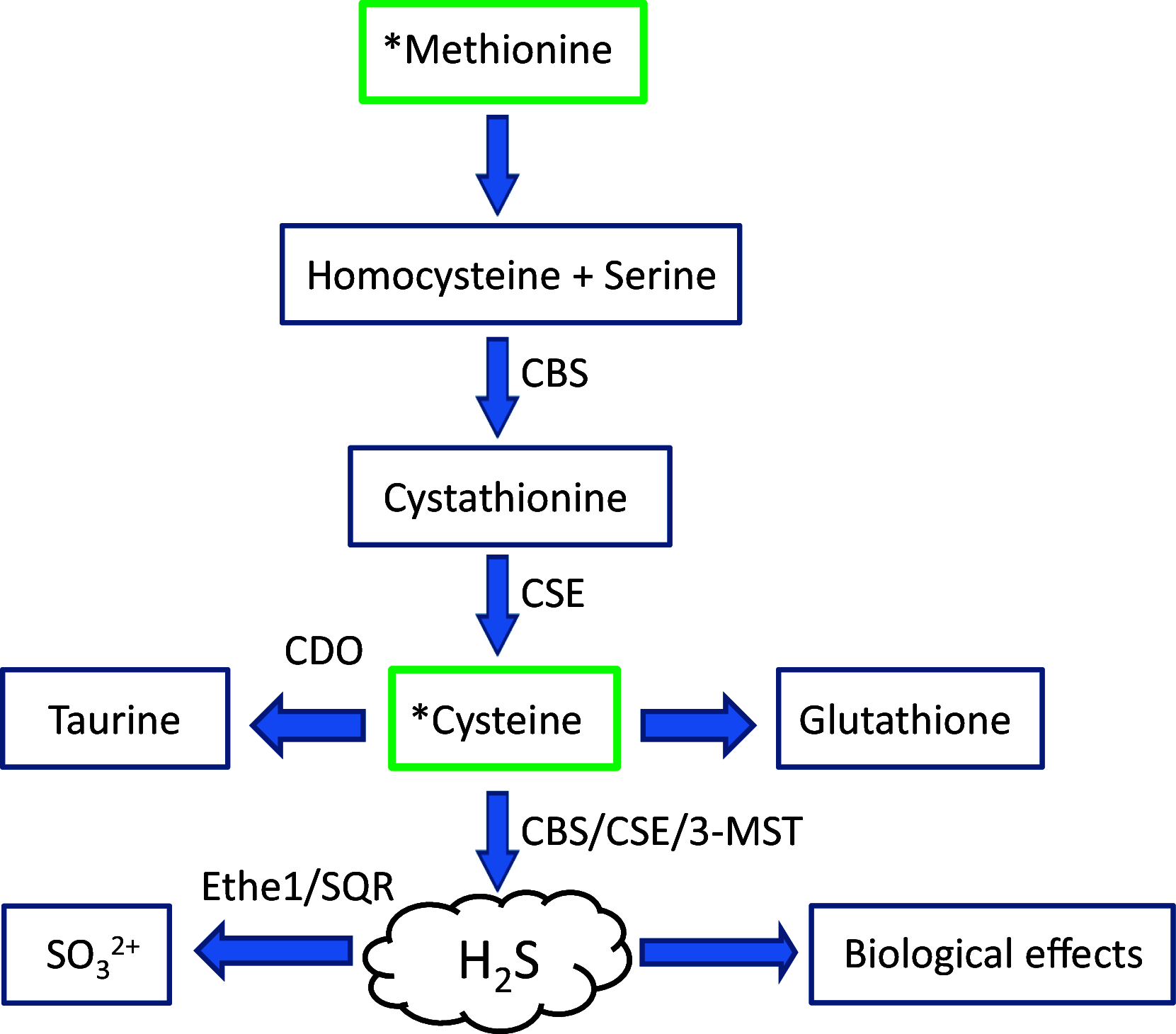H2S biosynthesis and catabolism: new insights from molecular studies
- PMID: 27844098
- PMCID: PMC5357297
- DOI: 10.1007/s00018-016-2406-8
H2S biosynthesis and catabolism: new insights from molecular studies
Abstract
Hydrogen sulfide (H2S) has profound biological effects within living organisms and is now increasingly being considered alongside other gaseous signalling molecules, such as nitric oxide (NO) and carbon monoxide (CO). Conventional use of pharmacological and molecular approaches has spawned a rapidly growing research field that has identified H2S as playing a functional role in cell-signalling and post-translational modifications. Recently, a number of laboratories have reported the use of siRNA methodologies and genetic mouse models to mimic the loss of function of genes involved in the biosynthesis and degradation of H2S within tissues. Studies utilising these systems are revealing new insights into the biology of H2S within the cardiovascular system, inflammatory disease, and in cell signalling. In light of this work, the current review will describe recent advances in H2S research made possible by the use of molecular approaches and genetic mouse models with perturbed capacities to generate or detoxify physiological levels of H2S gas within tissues.
Keywords: Biosynthesis; Catabolism; Hydrogen sulfide; Molecular models.
Figures


Similar articles
-
The response of Caenorhabditis elegans to hydrogen sulfide and hydrogen cyanide.Genetics. 2011 Oct;189(2):521-32. doi: 10.1534/genetics.111.129841. Epub 2011 Aug 11. Genetics. 2011. PMID: 21840852 Free PMC article.
-
Bioenergetic relevance of hydrogen sulfide and the interplay between gasotransmitters at human cystathionine β-synthase.Biochim Biophys Acta. 2016 Aug;1857(8):1127-1138. doi: 10.1016/j.bbabio.2016.03.030. Epub 2016 Mar 31. Biochim Biophys Acta. 2016. PMID: 27039165 Review.
-
Endogenous production of hydrogen sulfide in human sinus mucosa and its expression levels are altered in patients with chronic rhinosinusitis with and without nasal polyps.Am J Rhinol Allergy. 2014 Jan-Feb;28(1):12-9. doi: 10.2500/ajra.2014.28.3972. Am J Rhinol Allergy. 2014. PMID: 24717871
-
Interaction of Hydrogen Sulfide with Oxygen Sensing under Hypoxia.Oxid Med Cell Longev. 2015;2015:758678. doi: 10.1155/2015/758678. Epub 2015 May 11. Oxid Med Cell Longev. 2015. PMID: 26078818 Free PMC article. Review.
-
Hydrogen Sulfide Contributes to Retinal Neovascularization in Ischemia-Induced Retinopathy.Invest Ophthalmol Vis Sci. 2016 Jun 1;57(7):3002-9. doi: 10.1167/iovs.15-18555. Invest Ophthalmol Vis Sci. 2016. PMID: 27273718 Free PMC article.
Cited by
-
ETHE1 dampens colorectal cancer angiogenesis by promoting TC45 Dephosphorylation of STAT3 to inhibit VEGF-A expression.Cell Death Dis. 2024 Aug 28;15(8):631. doi: 10.1038/s41419-024-07021-w. Cell Death Dis. 2024. PMID: 39198402 Free PMC article.
-
Modeling SILAC Data to Assess Protein Turnover in a Cellular Model of Diabetic Nephropathy.Int J Mol Sci. 2023 Feb 1;24(3):2811. doi: 10.3390/ijms24032811. Int J Mol Sci. 2023. PMID: 36769128 Free PMC article.
-
The Roles of NO and H2S in Sperm Biology: Recent Advances and New Perspectives.Int J Mol Sci. 2020 Mar 21;21(6):2174. doi: 10.3390/ijms21062174. Int J Mol Sci. 2020. PMID: 32245265 Free PMC article. Review.
-
Reactive Sulfur Species: A New Redox Player in Cardiovascular Pathophysiology.Arterioscler Thromb Vasc Biol. 2020 Apr;40(4):874-884. doi: 10.1161/ATVBAHA.120.314084. Epub 2020 Mar 5. Arterioscler Thromb Vasc Biol. 2020. PMID: 32131614 Free PMC article.
-
Sulfhydrylated albumin mitigates Acetaminophen-induced liver injury by restoring the integrated H2S-albumin thiol antioxidant network.Redox Biol. 2025 Sep;85:103774. doi: 10.1016/j.redox.2025.103774. Epub 2025 Jul 17. Redox Biol. 2025. PMID: 40694957 Free PMC article.
References
-
- Yang G, Sun X, Wang R. Hydrogen sulfide-induced apoptosis of human aorta smooth muscle cells via the activation of mitogen-activated protein kinases and caspase-3. FASEB J. 2004;18:1782–1784. - PubMed
Publication types
MeSH terms
Substances
LinkOut - more resources
Full Text Sources
Other Literature Sources

